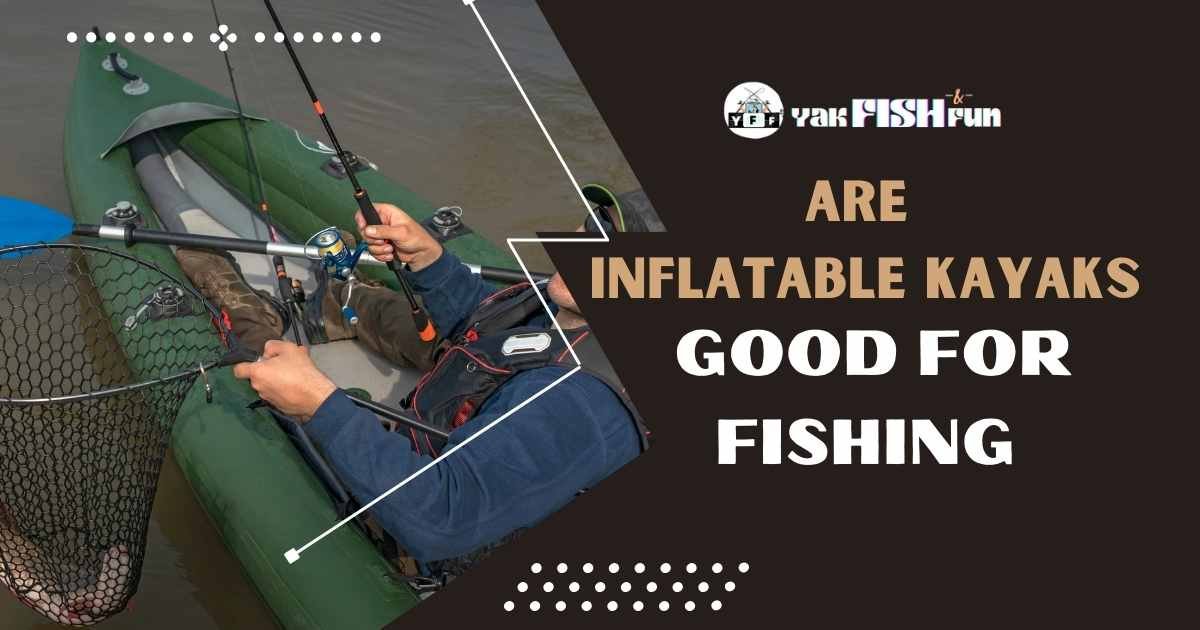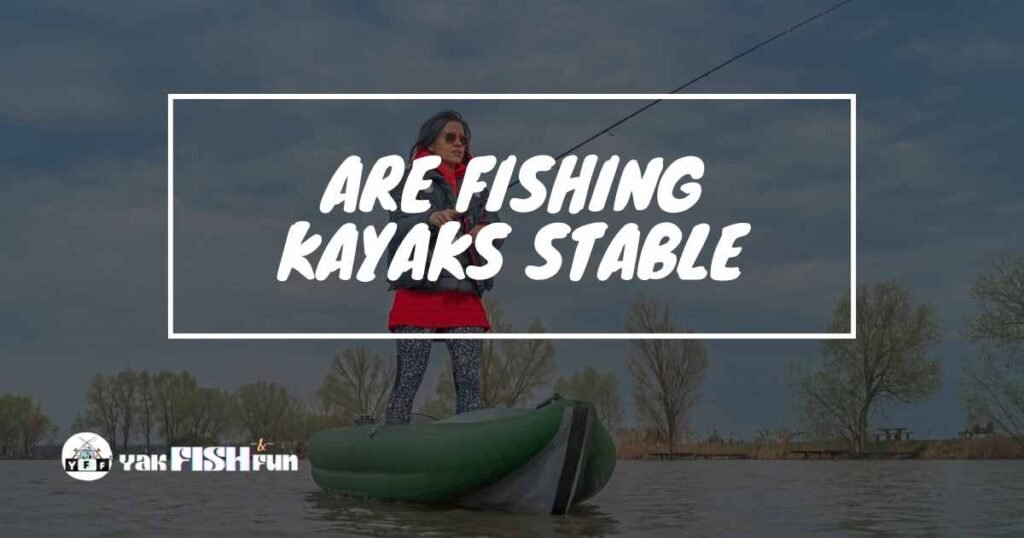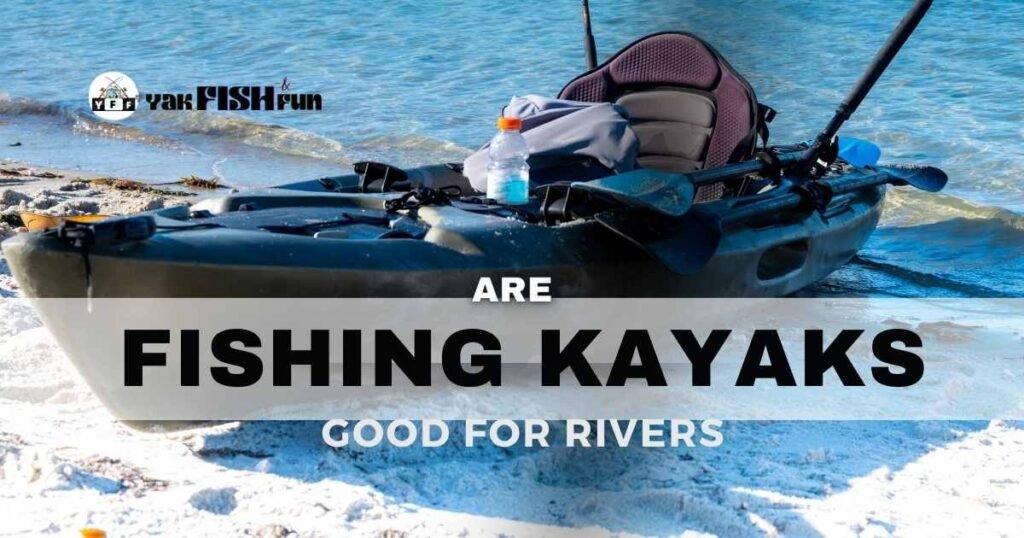Fishing kayaks have gained immense popularity among river anglers, offering a distinct advantage over traditional fishing boats. With their maneuverability and versatility, fishing kayaks provide an exceptional experience for those seeking to explore rivers in search of the perfect catch.
But are fishing kayaks good for rivers? Absolutely! Fishing kayaks offer versatility like the Swiss Army knives of river adventures. But success depends on picking the perfect kayak and mastering river skills.
Unlike larger boats, fishing kayaks are designed to easily navigate narrow waterways and shallow depths, allowing anglers to access remote areas that may be inaccessible by other means. This opens up a world of possibilities for exploring hidden spots where fish tend to gather.
Table of Contents

Evaluating The Effectiveness Of Fishing Kayaks For Rivers
Fishing kayaks are great for people who want to go fishing in rivers and waterways. They’re easy to control, don’t tip over easily, and can reach places that are far away and not easy to get to. That’s why they’re a favorite among those who love fishing in rivers.
Maneuverability: Navigating Rapids And River Currents
Fishing kayaks are really good at being easy to steer. They can move well in tight places like narrow rivers, sharp turns, and even fast-moving water. Because they’re small and designed to glide smoothly, people using fishing kayaks can easily paddle around things in their way. This helps them get to secret fishing spots where fish usually hang out.
Accessing Remote Areas
Fishing kayaks allow anglers to explore parts of a river that are otherwise inaccessible by larger boats. These nimble vessels can traverse shallow waters, allowing fishermen to reach secluded spots teeming with fish. Whether it’s a quiet bend or a hidden cove, kayak anglers have the freedom to explore every nook and cranny of the river.
Stability In River Currents
Staying steady is really important when you’re out on the water. Fishing kayaks are made with special features that help them stay stable, even in moving water. The shape of the bottom part of the kayak called the hull, is a big factor in how well it balances when you’re paddling against the current or going over small waves.
Kayaks with wider hulls are better at staying stable than the regular ones, so you can fish without the worry of tipping over.
Control And Excellent Tracking
Fishing kayaks have a special design that makes them great for controlling in rivers. Lots of these kayaks have something called “gear tracks” where you can attach things like rod holders or fish finders. This makes fishing even better because you can keep your gear handy and easy to reach while you’re on the water.
Load Capacity For Fishing Gear
Another advantage of fishing kayaks for river angling is their impressive load capacity. Anglers can bring all the necessary gear, including tackle boxes, fishing rods, coolers, and camping equipment. The ample storage space ensures that fishermen are well-prepared for extended trips on the river.
Pros And Cons Of Using Fishing Kayaks In Rivers
Fishing kayaks have gained popularity among anglers for their versatility and maneuverability on various waterways. Using fishing kayaks has its own set of advantages and disadvantages. Let’s explore the pros and cons of utilizing these kayaks for angling in river environments.
Pros Of Using Fishing Kayaks In Rivers
Fishing kayaks are a popular choice for anglers who want to find hidden fishing spots in rivers and waterways. They have great maneuverability and can take you to remote fishing areas that not many people can reach. Let’s dive into why they’re so good:
- Lightweight and easy to transport: Fishing kayaks are usually lightweight, so it’s easy to carry them to different spots along the river. This makes it simple for anglers to explore various parts of the river without any trouble.
- Cost-effective compared to motorized boats: Compared to motorized boats, fishing kayaks are generally cheaper. You don’t have to spend money on fuel or boat maintenance, making fishing kayaks a budget-friendly choice for river enthusiasts.
- Silent movement doesn’t scare away fish: Fishing from a kayak has a big advantage. It moves silently through the water. Unlike larger motorized boats that can be noisy, kayaks glide quietly. This stealthy approach doesn’t disturb the fish, preventing them from getting scared away.
- Excellent tracking capabilities: Many modern fishing kayaks come with advanced features like pedal drives or rudders that help you control the kayak’s direction. This means you can navigate precisely along the river currents, improving your fishing experience.
Cons Of Using Fishing Kayaks In Rivers
Fishing kayaks are popular because they’re versatile and easy to use in rivers. However, it’s essential to be careful and informed when using them. Like any tool, fishing kayaks have some drawbacks that anglers should be aware of before their river adventures. Let’s take a closer look at what these limitations are:
- Skill Requirement: Using fishing kayaks can be a lot of fun, but it’s important to know that handling them in rivers with different currents and potential dangers takes some specific skills. If you’re new to kayaking, it can be tough to control the kayak, especially in fast-moving water or rapids. To stay safe, you’ll need to learn how to paddle properly, understand the river, and be aware of safety rules. Without these skills, there’s a higher chance of the kayak flipping over or getting stuck in tricky situations.
- Storage and Transportation: Fishing kayaks can be bulky and challenging to store and transport, especially for individuals with limited storage space. You may need to invest in roof racks or specialized storage solutions.
- Requires physical effort to paddle against strong river currents: Paddling against strong river currents is physically demanding. When the current is powerful, you’ll need to put in a lot of effort to move your fishing kayak upstream. This can be exhausting, especially if you spend a long time on the water or if the river conditions are challenging.
Even though fishing kayaks have their downsides, they’re still a top choice for anglers who want to explore rivers. They’re great at maneuvering, work well in different water conditions, and are stable. Plus, recent improvements in kayak design have helped make them more comfortable and offer better storage options.
So, despite the drawbacks, many people still love using fishing kayaks for their river adventures.
Tips For Successful River Fishing With A Kayak
River fishing with a kayak can be an exhilarating adventure, allowing anglers to explore untamed waters and discover hidden fishing havens. However, it also presents unique challenges that require careful planning and execution.
Let’s explore a few tips for successful river fishing with a kayak.
Choose The Right Kayak Size And Design Suitable For River Conditions
Selecting the appropriate kayak size and design is crucial. The right kayak will ensure you have a smooth and enjoyable fishing experience on the river. Consider the following factors when choosing your fishing kayak:
- Size: Opt for a smaller-sized kayak that allows for easy maneuverability in narrow river channels. A compact kayak will enable you to navigate tight spots, making reaching those hidden fishing spots easier.
- Design: Look for kayaks specifically designed for river fishing. These kayaks often have a flat hull or a shallow V-shaped bottom, providing better stability in fast-flowing rivers and preventing tipping over.
- Weight: : Choose a lightweight kayak that can easily carry over obstacles or portage when necessary. This will make navigating rocky sections or shallow areas more manageable.
- Durability: When you’re in rivers, you might come across rough conditions with rocks and debris. In those situations, it’s a good idea to choose a strong kayak made from tough materials like polyethylene or composite materials. These materials can handle bumps and hits without getting damaged.
Familiarize Yourself With The River’s Flow Patterns And Potential Hazards
Before you go on your river fishing trip, take the time to learn about how the river behaves. Understanding how the water moves in the river is crucial for successful fishing in a kayak:
- Currents: Find out where the currents are strong or weak. This affects how fish behave and where they look for food.
- Eddies: Eddies are circular currents that form behind obstacles like rocks or fallen trees. They create calm areas where fish like to hang out.
- Obstacles: Be cautious of potential dangers like rocks under the water, fallen trees, or branches hanging low. These things can block your way or be unsafe.
To enhance your safety while enjoying your river fishing experience, consider the following precautions:
- Safety Gear: Always wear a well-fitting life jacket or personal flotation device (PFD) when you’re kayaking on rivers. This keeps you safe in case you tip over or face unexpected situations.
- Inform Someone: Before you go, tell someone about your fishing plans, including where you’re going and when you plan to return. This way, if something unexpected happens, they can get help for you.
Use Appropriate Fishing Gear And Accessories
Successful fishing journeys are often a harmonious blend of skill, strategy, and the right tools. As an angler, your choice of fishing gear and accessories can be the defining factor between a rewarding day on the water and a frustrating one. Here’s what you’ll need:
- Invest in a sturdy and stable fishing kayak specifically designed for river fishing. Look for features such as a wide hull for stability, a comfortable seat, and ample storage space for your gear.
- Use a paddle specifically designed for kayak fishing on rivers. These paddles are often shorter and wider, allowing for better maneuverability in narrow and shallow river waters.
- Consider using a kayak anchor system to keep your kayak in place while fishing. This will allow you to focus on your fishing without worrying about drifting away with the current.
- Utilize a kayak fish finder to locate fish and determine the depth of the water. This handy tool can greatly improve your chances of success by helping you identify prime fishing spots in the river.
- Use a fishing rod holder to keep your fishing rod secure and easily accessible while you paddle or wait for a bite. This will free up your hands and make navigating the river easier or handling other fishing tasks.
- Pack a dry bag or waterproof container to keep your personal belongings and electronic devices safe and dry while out on the water. River conditions can be unpredictable, so protecting your valuables from water damage is important.
- Wear appropriate safety gear, such as a life jacket, when fishing from a kayak in rivers. Even if you are a strong swimmer, unexpected accidents can happen, and it’s better to be safe than sorry.
- Consider using a kayak cart or trolley to transport your fishing kayak to and from the river. This will make it easier to navigate rough terrain and save you from straining your back and arms.
- Pack a first aid kit and familiarize yourself with basic first aid techniques. Accidents can happen, and being prepared will ensure you can handle any minor injuries or emergencies while fishing on the river.
- Lastly, don’t forget to bring along appropriate fishing gear and accessories, such as fishing tackle, bait, a landing net, and a cooler to keep.
Factors To Consider When Choosing A Fishing Kayak For Rivers
Selecting the right fishing kayak for river adventures is a decision that can greatly influence your angling experiences. With the vast array of kayak options available, each tailored to specific needs, making an informed choice is crucial.
Here’s what you need to consider when choosing a fishing kayak for rivers.
Stability
Stability is paramount. You want a kayak that can withstand the unpredictable currents and obstacles you may encounter. Look for kayaks with wider hulls or pontoon-style designs, as they offer better stability in river conditions. These designs distribute the weight more evenly, making it easier to maintain balance while casting your line or reeling in a big catch.
Maneuverability
In fast-flowing rivers, maneuverability is key. You need a kayak that can easily navigate narrow channels and tight turns. Opting for a shorter kayak allows for greater agility and responsiveness on the water. With a shorter length, you’ll easily control your movements and swiftly change directions when needed.
Storage Capacity
When you go on fishing trips, you usually need to bring along a bunch of gear and equipment. So, it’s important to think about how much storage space your fishing kayak has, especially when you’re using it in rivers. You want a kayak that has enough room to store all your stuff, but you also need to pay attention to how much weight it can handle. You need to make sure the kayak can comfortably carry both your gear and your weight.
Some popular kayaks, like the ones from Vibe Kayaks, are well-known for having lots of storage space. They’re made with fishing enthusiasts in mind and have special compartments for storing your things, as well as places where you can attach extra stuff like rod holders or fish finders.
To help you pick the right fishing kayak based on how much storage you need, it’s a good idea to make a list of all the important things you usually bring on your fishing trips. This way, you can figure out how much space you’ll need and use that info to help you choose the right kayak.
Best River Fishing Kayaks: Top 3 Kayaks For River Anglers
If you’re a fisherman who wants to explore rivers and catch fish in an adventurous way, fishing kayaks are a great choice. These special kayaks are made to handle the unique challenges of river fishing. They offer stability, maneuverability, and convenience.
#1 Wilderness Systems Tarpon 120
The Wilderness Systems Tarpon 120 is one of the best kayaks for river fishing. It’s compact, which makes it easy to navigate through narrow channels and shallow waters. This kayak has a comfy seat with an adjustable backrest and foot braces, so you can enjoy long hours on the water. It’s very stable, so you don’t have to worry about tipping over while you’re casting your line. The Tarpon 120 also has plenty of storage space for all your fishing gear.
#2 Old Town Predator MX
Another great kayak for river anglers is the Old Town Predator MX. This kayak is known for being super stable and durable, making it perfect for rough river conditions. It has a roomy deck layout that makes it easy to access all your fishing gear while staying balanced on the water. The adjustable Element seating system keeps you comfortable during long fishing trips. Plus, it comes with rod holders and storage options, so all your fishing gear is easily accessible.
#3 Jackson Kayak Coosa HD
The Jackson Kayak Coosa HD is designed especially for people who like to fish in rivers. It’s really good at maneuvering and controlling itself, so you can easily get through tight spots. The kayak’s special hull design keeps it steady, even when you’re in fast currents or rapids, which are common in rivers. It also lets you set up the kayak the way you want and has plenty of space for your gear.
These top kayaks are excellent for anglers. Whether you want a small kayak that’s easy to move or a sturdy one that lasts, you’ll find a kayak on this list that’s right for you.
The Bottom Line
To sum it up, fishing kayaks are a good choice for rivers, giving anglers a flexible and efficient way to move on the water. When we look at how well fishing kayaks work in rivers, we see they have lots of benefits, like being easy to steer, quiet, and able to reach shallow spots. But it’s important to think about both the good and not-so-good things before you decide. Fishing kayaks are great because they’re easy to carry and don’t cost as much, but they might not be as stable and could have less space for your stuff.


